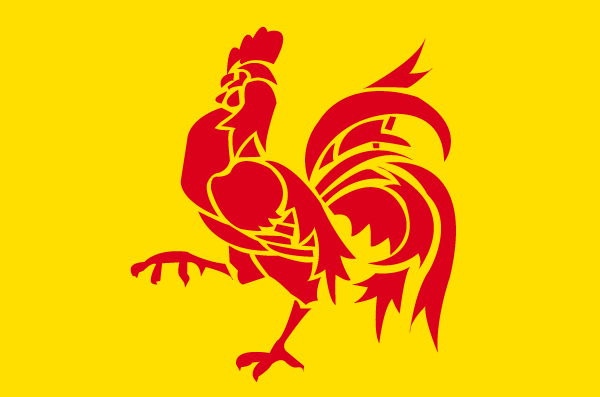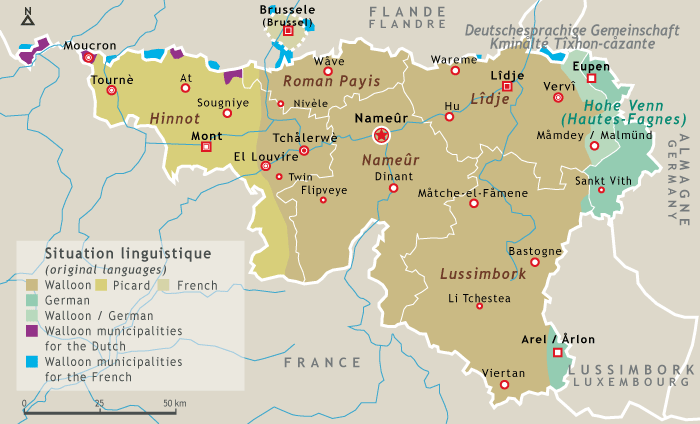Wallonia, the survival of an Oïl people

Wallonia is situated on the margins of the Roman and Germanic worlds. Linguistically, the Walloons, as well as the Picards and the Normans, make up part of the Oïl people. Politically, however, they are marked by a history of conflicts between micro-territories and unions in larger groups.

Populated initially by the Celtic tribe of the Belgii, Wallonia was conquered by Caesar and was strongly Romanised. After the collapse of the Roman Empire, Wallonia saw the emergence of the kingdom of the Franks, as well as the Carolingian dynasty, of Liégeoise origin, mixing its history with that of northern France. Following the Treaty of Verdun, it returned to Lorraine and then integrated into the Germanic Holy Roman Empire. After a feudal period dividing it into independent micro-territories that were regularly in conflict, vast counties and duchies were created (Namur, Brabant, Luxembourg, Hainaut), controlled by the Burgundian power, Spain, and then Austria.
The principality of Liège became involved in the French Revolution and France profited from annexing the region and dividing it into departments, based on provinces. Integrated with the Netherlands in 1815, Wallonia rebelled in 1830, leading to the creation of Belgium, born of an arranged marriage requiring the co-existence of two very different people: the Walloons and the Flemish.
The Industrial Revolution made Wallonia rich in natural resources, until its decline in the 1960s. Belgium turned towards federalism. The Walloons wanted economic autonomy so that they would no longer depend on the Flemish majority. The movement accelerated until the abolition of federalism in the 1990s.

Identity card

| Name | Waloneye | Walloon Wallonie | French Wallonien | German Wallonië | Flemish/Dutch |
| Population | 3,633,795 inhab. (2019) |
| Area | 16,845 km² |
| Languages | Walon | Walloon (recognised) Français | French Deutsch | German (official) Vlaams/Nederlands | Flemish/Dutch |
| Number of native speakers | 600,000 | Walloon (including 300,000 active speakers) (2017) |
| State of guardianship | Belgium, France |
| Official status | Federal region in Belgium, No status in France |
| Capital | Nameûr | Walloon (Namur) |
| Historic religion | Roman Catholic |
| Flag | Li cok walon | Walloon (The Walloon Rooster) |
| Anthem | Li tchant des Walons | Walloon (The Song of the Walloons) |
| Motto | Walon todi | Walloon (Always Walloon) |

Timeline

- AD 57 • The Romans invade Belgian Gaul.
- 5th century • The Franks settle in the country that will become the centre of their future kingdom.
- 843 • Treaty of Verdun, Wallonia is incorporated into Lorraine.
- 15th century • Burgundian rule over the country except for the principality of Liège. Spanish then Austrian annexation.
- 1795 • Following the French Revolution, Wallonia is annexed to the Republic (creation of the departments of Jemappes, the Dyle, Sambreet- Meuse, Forêts and Ourthe).
- 1815 • Defeat at Waterloo, the Walloons are fighting with the Napoleonic troops. Wallonia is annexed to the kingdom of the Netherlands.
- 1830 • Formation of Belgium, made up of Wallonia and Flanders.
- End of the 20th century • Wallonia becomes a region in the framework of Belgian federalism. It has widespread autonomy and posseses a parliament and government.

Brief history

If the Walloons have been a people for a long time, it was not until 1950 that this cultural notion took its own political dimension. In that year, the “royal question” divided Belgium. In a referendum, the Belgians were asked if they wanted the return of King Leopold III, whose behaviour during the war had been questioned. The Walloons voted “No” while the Flemish voted “Yes”. Because of their demographic weight the latter allowed the king to return. This return was accompanied by serious riots in Wallonia, which resulted in three deaths at Grâce-Berleur when the police fired at the crowd. A “Walloon government” assembled in Liège and wished to declare independence. Léopold III eventually abdicated but the tensions between the Walloons and the Flemish were never resolved. Following that, tensions increased and provisionally led to federalism.

Geography

Without access to the sea, Wallonia is enclosed between Flanders and the Netherlands to the north, Germany and Luxembourg to the east and France to the south and west. It is made up of two large geographical areas separated by the Sambre-et-Meuse furrow, the two main rivers of the region: to the north-west the plateaus of Hainaut, Brabant and Hesbaye, to the south-east the high plateaus of Condroz, the Famenne, the Ardenne and Gaume. An economically developed region with an indigenous population, the “Walloon ridge” crosses the country of Tournais, through Mons, Charlerois, Namur, Huy, Liège as far as Verviers. To the east of Wallonia, we find the High Fens, populated by German speakers.



